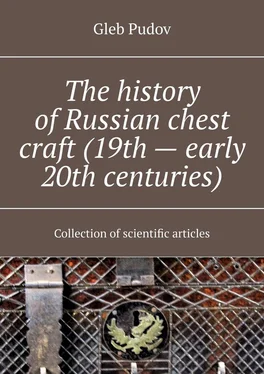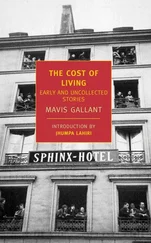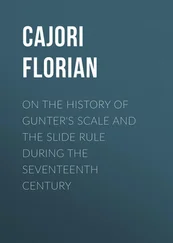Published : Русские сундуки-подголовники: художественный стиль и культурно-исторический контекст // Вестник культуры и искусств. – 2020. – №2 (62). – С. 71—77.
The chest images in painting
From the dawn of time, the chest has been used to store valuables, documents, and food supplies. It played a special role in the wedding ceremony. It is not surprising that from an early time the chest was reflected in the works of fine arts.
In the scientific literature, this topic has not received sufficient coverage, although in some works there are references to the image of certain chests and caskets in paintings, book miniatures, frescoes, icon painting 72 72 See for example: Гончарова Н. Н. Русские расписные сундуки XVII – XVIII вв. в собрании Исторического музея. – М.: ГИМ, 2018, С. 9, 10, 11.
. Researchers most often only state the fact of the image of certain chest products. Perhaps the most thorough research in this area belongs to the german researcher Paul Schubring 73 73 Schubring P. Cassoni. Truhen und Truhebilder der italienischen Frürenaissance. —Leipzig: Verlag von Karl W. Hierseman, 1915, S. 68—76.
. His work, however, deals only with italian cassones (wedding chests).
This paper attempts to summarize information on this topic, trace the features of the image of chest products in the works of easel and monumental painting, book graphics.
It should be emphasized that the author involved only the most demonstrative works of art. The number of images of chests and caskets is truly limitless, it is impossible to cover everything in one review.
I
As early as in the painting of antique vases one can see chests and caskets with flat or sloping lids, each of which consists of four pillars and walls made of several planks. Sometimes the products are depicted in such detail that not only the design differs, but also the colors and ornamental motifs. These items were used in religious ceremonies and as home furniture. As an example antique vases from the Hermitage collection can be indicated 74 74 Inv. №№ Б.500, Б.504, Б.511, Б.524, Б.1658, Б.1700, Б.1703 and other.
. Based on these drawings, we can conclude that the oldest design used to create furniture in ancient Egypt has retained its popularity.
Images of chests and caskets in Italian Renaissance art are most common. Some of them are made very carefully, so they are used as historical sources. A fresco by Giotto from the Scrovegni Chapel in Padua (1304—1306; in the scene of the Annunciation to St. Anne) shows a large red chest with a flat lid and straight walls. It is upholstered with thin iron strips, on the front side there is a figured metal plate protecting the lock. According to Italian tradition, the chest is in the bedroom. In this case, we can name two works by the Sienese artist Sano di Pietro. The first is The Nativity of the Virgin (1448—1452), in which cassone chests stand along the beds 75 75 Stored in the Museum of Art of the University of Michigan (Ann Arbor, USA).
. The front side of each of them is decorated with a painted floral ornament against a gold background, located in three rectangular figures. Since the lids on the chests are flat, the latter are used as benches. In another work by Sano di Pietro, The Birth and Naming of John the Baptist (1450—60) 76 76 Collection of the Metropolitan Museum of Art (New York), inv. №1975.1.44.
cassons are also located along the beds. Unlike the chests depicted on the previous canvas, they are devoid of painting. Their only decoration is profiled panels. Antonello da Messina on the canvas «Saint Jerome at work» (around1475) 77 77 Stored in the National Gallery (London), inv. № NG 1418.
depicted a small chest with a flat lid and carved legs, reminiscent of Stollenrtuhe (one of the common types of chests). It is locatecd to the right of the saint. The item is devoid of any decorations, it is simple and elegant. And in the famous painting by Titian «Venus of Urbino» (1538) 78 78 Stored in the Uffizi (Florence), inv. №1890 no. 1437.
two chests are shown in the background. They have rounded walls and are decorate perhaps with intarsia. The ornament consists of whimsically twisting vegetative scrolls and anthropomorphic images. Even on the front panels of the chests themselves, wedding cassones were depicted, as, for example, on a Florentine work of the 15th century from the collection of the State Hermitage 79 79 Фаенсон Л. Доска от кассона флорентийской работы XV века с изображением свадебного празднества // Сообщения ГЭ. Вып. XXXV. – Л.: Аврора, 1972, С. 11—13. See also: Faenson L. Italian cassoni from the art collections of Soviet museums. – L.: Avrora Art publishers, 1983, p. 28, 32.
. Two servants on a donkey carry richly decorated chests with sloping lids. Their sizes do not correspond to the real ones. Examples of the image of Italian chests on frescoes, canvases and panels can be listed almost endlessly. Thus, based on the images examined, it can be concluded that chest production has developed significantly: in the 15th century in Italy, various designs and techniques for decorating products were used.
Painters of other countries also paid attention to chest items. On the triptych of Pieter Aartsen «Adoration of the Magi» (1560) 80 80 Stored in the Rijksmuseum. Inv. № SK-A-1909. See: Os H. van, Kok J.P.F., Luijten G., Scholten F. Netherlandish art in the Rijksmuseum. 1400 — 1600. Rijksmuseum, Amsterdam. Zwolle: Uitgeverij Waanders b.v., 2000, p. 193.
a large chest is depicted in some detail. It has a sloping lid reinforced with thin wooden strips from the inside; walls are straight, upholstered with iron strips, on the sides there are handles and terer are no legs. The chest may have been upholstered with leather having an ornament made in the embossing technique. And on the canvas of Hieronymus Bosch «Death of a Merchant» (1485—1490) 81 81 Stored in the National Gallery of Art (Washington), inv. №1952.5.33. See: https://www.nga.gov/collection/art-object-page.41645.html.
even more detailed than the thing discussed above, a chest is depicted, reproducing the design of tuugkist («sarcophagus») chests. In the grooves of the four «pillars» the boards are strengthened (they also form the legs) that make up the walls. The lid is flat, it was raised and lowered with the help of wooden hinges. The front side of the chest (lower part) is decorated with geometric motifs performed in carving technique. Attention is drawn to the powerful iron plate that protects the key hole. It consists of two parts of different shapes (triangular and round), superimposed on each other. A long iron hinge is attached to the lid. The title is on the left. An interesting detail shows how the lid was held up: a dagger was used. In German painting, images of chest products are no less common. They can be seen, for example, on Stefan Lochner’s Altar of the Cologne City Cartridge (after 1426), on his own painting Madonna in the Gazebo (1440), on the left wing of the Isenheim Altarpiece by Matthias Grunewald (1506—1515). There is a chest with flat lids and walls, consisting of paneled panels; a chest with a flat lid, the walls of which are connected «in a dovetail»; richly decorated casket with a gable lid. The desire of German painters for a reliable depiction of objects (which is called by researchers as one of the features of German Renaissance painting 82 82 Либман М. Я. Дюрер и его эпоха. Живопись и графика Германии конца XV и первой половины XVI века. – М.: Искусство, 1972, С. 29—30, 176 and others.
) made it possible to consider their canvases as a source of the history of everyday life.
Читать дальше












